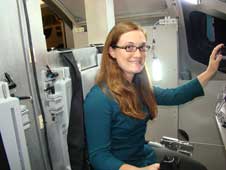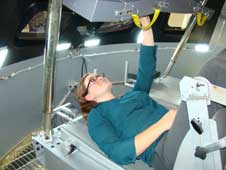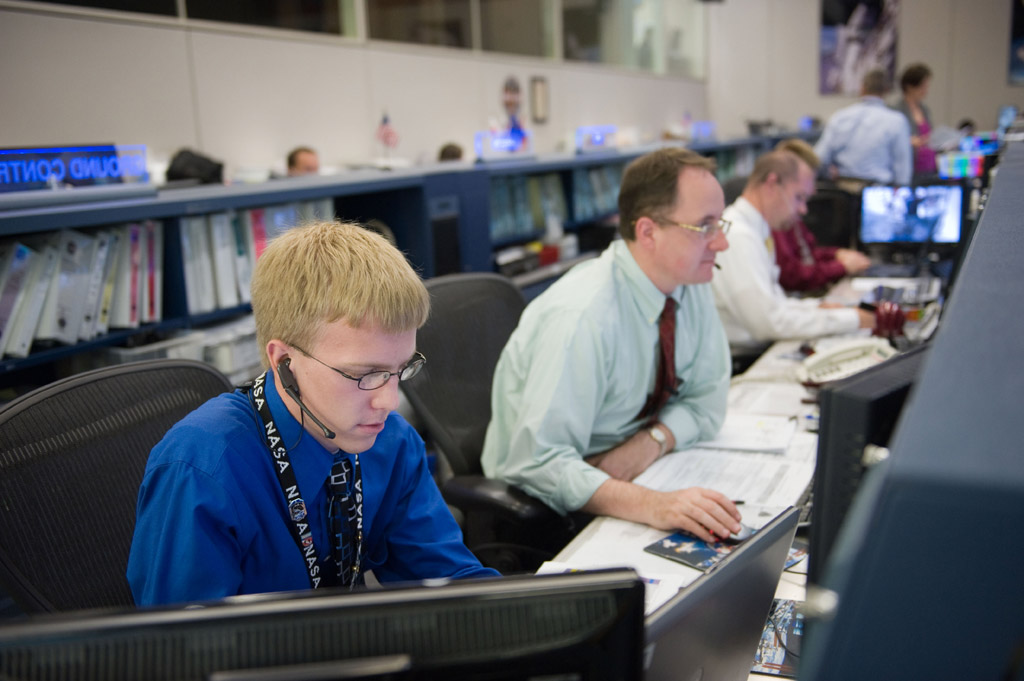November 30, 2010 Vol. 3, Issue 11
Kat Coderre’s career started with a phone call from out of the blue. “Can you be in Houston tomorrow night?”
[Editor’s note: This is the first in a regular series of profiles of young professionals working in the aerospace profession.]

Kat Coderre in the Cockpit Operators Station Mockup, which is used to run rendezvous docking simulations for Orion. Photo Credit: Lockheed Martin
When Lockheed Martin won the Orion contract in 2006, it had Kat Coderre’s application on file—one of 32,000. “We want you to come out,” Coderre remembers the voice on the other end of the line saying.
“I flew from New York to Houston that evening,” she says with a laugh. Fresh out of college with a degree in Aeronautical and Mechanical Engineering from Rensselaer Polytechnic Institute, Coderre was among 1,200 engineers asked to join the Lockheed Martin team. Standing with her peers, she recalls thinking, “I am fresh out of school and working on a spaceship. That’s pretty cool.”
The journey leading up to that phone call began with an early fascination with the moon, her first telescope, and a trip to Space Camp, where she later became a counselor. Four years after the trip to Houston, she is part of Lockheed Martin’s Engineering Leadership Development Program, an active member in a variety of outreach programs, and a member of the Space Generation Advisory Council. In short, Coderre is part of the generation of young professionals who entered the aerospace workforce when the Vision for Space Exploration reshaped the landscape in the middle of the last decade. Today she’s working to take her aerospace career and professional community to the next level.
Doing, Learning, and Mentors
“Theyd let me go off and learn, and gave me tough tasks to do. They weren’t holding my hand.”
As a 22-year-old starting out as an engineer on the Orion Flight Operations Integration Team, her job was to make Orion a more operable vehicle.
“I didn’t necessarily know what I was doing all of the time when I started, but there was a lot of encouragement, a lot of mentoring from the management, the more experienced folks,” she says. “They’d let me go off and learn, and gave me tough tasks to do. They weren’t holding my hand.”
Her growth as an engineer continues with her participation in the Engineering Leadership Development Program (ELDP) at Lockheed Martin. For three years, Coderre will spend six months to a year broadening her skill set and capabilities by jumping from project to project, in addition to getting her Masters degree. Her first ELDP rotation placed her with the cockpit design team for Orion, working on displays and controls for the system. The experience exposed her to a high customer-contractor interface, a team dynamic that she hadn’t yet experienced, and taught her how to work with the customer as a teammate. Coderre is now working on Lockheed Martin’s International Space Station Cargo Mission Contract team.

Kat Coderre in the Human Engineering Structural Mockup. This full-scale Orion mockup is used for crew evaluations such as ergonomic assessments and emergency egress operations. Photo Credit: Lockheed Martin
Throughout her four years at Lockheed, she has appreciated her mentors and their open-door policies. “I can just wander in if I see them in their office or if I need to discuss anything,” she explains. Her conversations range from technical discussions to broader topics such as uncertainty in the federal budget.
Working in Teams
Most of her professional challenges have revolved around people: learning how to work with different personality types, communication styles, and work styles.
She is quick to say that she has had great support, but has run into the occasional colleague who “looks at you like you’re a youngin’.” She views it as a challenge to prove that “I can do my job right, and do it well,” she says. “And when I do fail, [I] fess up to it.” Simply admitting, “I made a mistake,” Coderre adds, can go a long way. “If you don’t fess up to [a mistake], then they lose respect for you.”
Young, Old, and In Between
Her work and professional activities bring her into contact with people ranging from school children to retired aerospace veterans. She dedicates her time to public outreach, which started with her work at Space Camp, and expanded to volunteering at museums, the NASA Speakers Bureau, and the Challenger Learning Center. The next step to re-ignite the next generation’s interest in space “is trying to get exposure into other areas where [kids] don’t typically get [exposed to space],” she says. “It’s our duty to really give back and be that mentor, be that spark of interest to a student, whether they are elementary school or college level.”

A wide view of the lab with the Human Engineering Structural Mockup in the foreground and the Cockpit Operators Station Mockup in the background. Photo Credit: NASA
At the other end of the age spectrum, Coderre looks to the generations above her to learn from their knowledge and experience from the past. “Spaceflight is a tough business,” she says. “Taking those lessons and those various experiences, sitting down and talking with [the more experienced generation], showing them that we are interested and we want to hear what they’ve done [is important].” Coderre says that her generation is eager to make the most of lessons learned the hard way. “We respect their experience and we really do want to learn [from it].”
“The key is interaction; having as much small group interaction as possible.” She remembers a conference where she was able to bring her questions and discussion topics directly to veteran engineers seated at various tables in a room. The forum was so effective that at the end of the evening, said Coderre, “no one wanted to leave.”
As for her peers, Coderre advocates for flexibility and patience. “I believed in it (Orion). I put my heart and soul into it,” she says. The nation’s direction in human space flight changed, and her generation needs to respond appropriately. “The government and the way the government does business is changing.” Her focus is to not get discouraged. With the aerospace industry being asked to do more with less, says Coderre, her generation as a whole must believe in what they do and continue to move forward.
International Collaboration: Wait and See
As a member of the Space Generation Advisory Council, a regular attendee of the International Astronautical Congress, and a team member on the ISS Cargo Mission Contract at Lockheed Martin, Coderre is no stranger to the international scene. She loves hearing colleagues speak different languages down the halls and in offices for her ISS work, and hopes to see international cooperation heightened in the future.
“The world is getting smaller, we’re more connected, and we can learn a lot from each other.”
In her conversations with international peers, there is always great enthusiasm about working with NASA. At the same time, she finds it is nearly impossible to talk with colleagues about international collaboration without discussing export and import regulations like ITAR, which are often viewed as stunting the expansion of international projects. Until things change, Coderre encourages her international peers to continue building their experience and developing their expertise.
“I believe in international cooperation,” she says. “The world is getting smaller, we’re more connected, and we can learn a lot from each other.”






